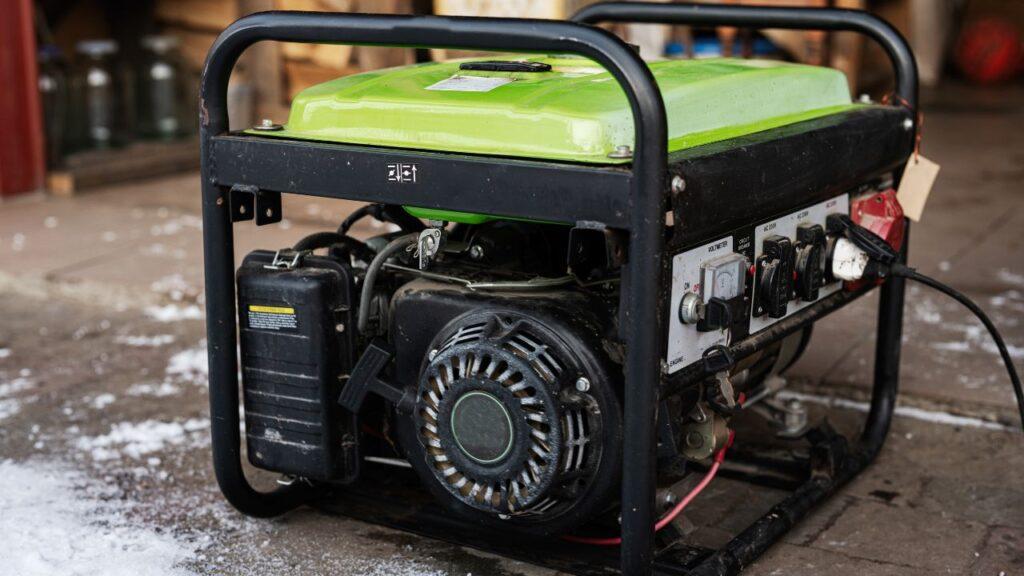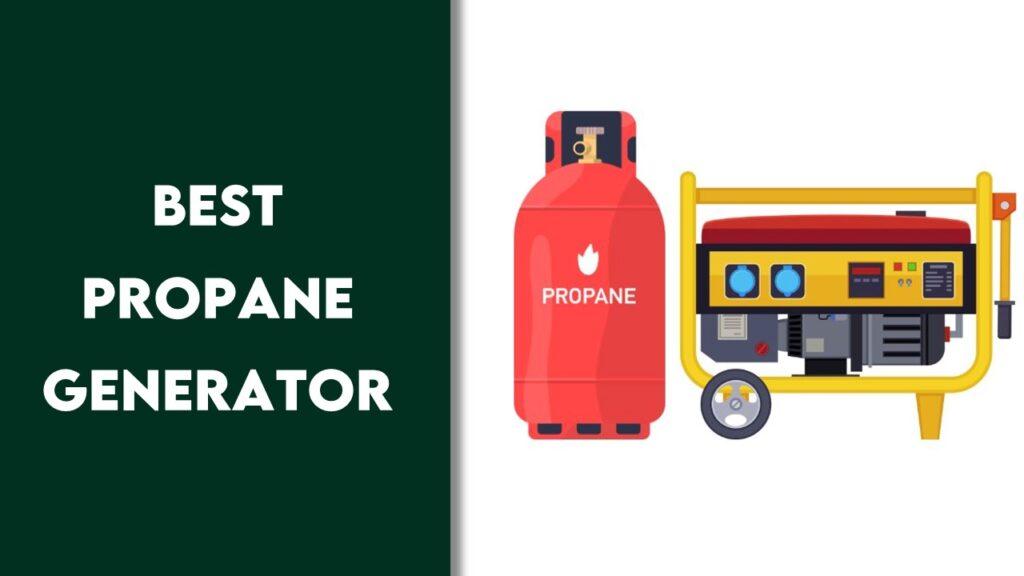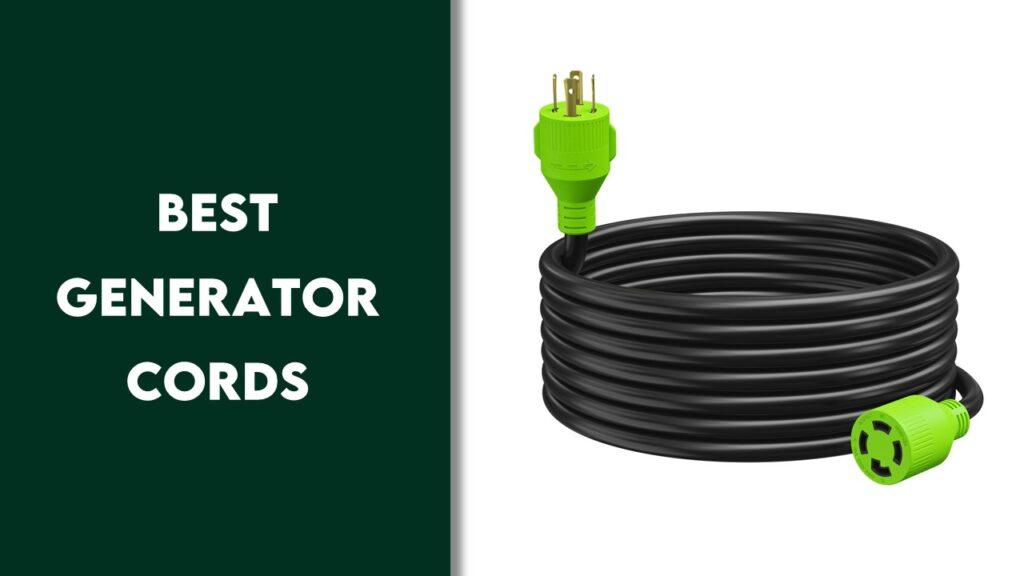Looking for power without the noise? These quietest portable generators in 2025 are designed for low sound levels and reliable performance. Whether you need backup power at home, silent energy for RV trips, or a peaceful camping setup, these models offer the perfect mix of quiet operation, portability, and efficiency.
We’re reader-supported. When you buy through links on our site, we may earn an affiliate commission. As an Amazon Associate, we earn from qualifying purchases.
Best Quietest Portable Generators: Our Top 7 Picks
1. Best Overall Option: Westinghouse 2550 Peak Watt
2. Best Budget Friendly Option: PowerSmart 2500-Watt
3. Best Lightweight Option: WEN 3600-Watt Portable Inverter Generator
4. Emergency Backup Option: Generac 7153 GP3300i
5. Best Compact Option: Honda EU2200ITAN 2200-Watt
6. Best Value for Money Option: YAMAHA EF2200iS Inverter Generator
7. Silent RV Camping: Champion Power Equipment 2500-Watt
1. Best Overall Option: Westinghouse 2550 Peak Watt

Key Specifications
- Brand: Westinghouse
- Weight: 43.2 pounds
- Dimensions: 19.5″L x 17.3″W x 17.9″H
- Starting Watts: 2550 watts
- Running Watts: 1900 watts
- Noise levels: As low as 52 dBA
- Running Time: Up to 12 hours (gasoline), up to 34 hours (propane)
- Fuel Tank Capacity: 1.11 gallons
From our perspective, the Westinghouse 2550 Peak Watt Dual Fuel Inverter Generator is a great fit for those looking for a quiet, reliable, and versatile power source. With the ability to run on both gasoline and propane, plus an ultra-quiet noise level, it’s perfect for residential use, camping, and RV trips. Lightweight yet packed with features, it balances performance and convenience effortlessly.
Capacity Test
The 2550 starting watts and 1900 running watts handled everyday appliances like refrigerators and fans effortlessly. From our experience, it supported multiple devices simultaneously, thanks to its clean, stable power output with less than 3% THD.
Noise Test
Operating as low as 52 dBA, this generator is impressively quiet. It’s quieter than most generators we’ve encountered, making it ideal for camping or residential use. From our standpoint, it created minimal disruption even during extended use, blending seamlessly into its surroundings.
Fuel Efficiency Test
The fuel efficiency was a standout feature. On gasoline, it ran for about 12 hours on a 1.11-gallon tank at 25% load. When using propane, it delivered up to 34 hours of runtime on a 20-pound tank. The “economy mode” further enhanced efficiency by adjusting engine speed based on load.
Build Quality
The build felt durable yet lightweight, weighing just over 43 pounds. Its compact size and built-in handle made it easy to carry around. From our perspective, the materials and design were both practical and built to last, ideal for outdoor and emergency use.
Safety Features
The CO sensor was a thoughtful addition, automatically shutting off the generator when unsafe levels of carbon monoxide were detected. Combined with low-oil and overload protection, it offered dependable safety for peace of mind.
Runtime, Fuel Options, and Tank Capacity
The dual-fuel capability added flexibility for different situations. Gasoline was convenient for shorter runs, while propane provided extended operation for longer needs. Its 1.11-gallon tank and efficient fuel consumption ensured uninterrupted performance during critical times.
Ports and Essentials
The generator comes equipped with an RV-ready TT-30R outlet, two 120V 20A outlets, and two USB ports. This setup made it versatile for powering a wide range of appliances and devices, from small electronics to larger home essentials, without needing additional adapters.
Appliances Operated With the Westinghouse iGen2550DFc Inverter Generator
Below are some of the appliances we operated using the Westinghouse iGen2550DFc, along with their starting and running wattages:
| Appliance | Starting Wattage | Running Wattage |
| Refrigerator | 1200 | 200 |
| LED TV | 150 | 120 |
| Coffee Maker | 800 | 800 |
| Laptop | 50 | 50 |
| Electric Fan | 120 | 40 |
Pros
- Dual-fuel capability for added flexibility.
- Quiet operation with noise levels as low as 52 dBA.
- Lightweight and portable with a compact design.
- CO sensor for enhanced safety during use.
Cons
- Propane runtime dependent on tank size.
- Parallel cables sold separately for increased power.
From our standpoint, the Westinghouse 2550 Peak Watt Dual Fuel Generator is an excellent choice for anyone seeking a flexible and quiet power solution. Its lightweight design, dual-fuel capability, and impressive runtime make it ideal for camping, RVs, and even home backup. With its reliable performance and thoughtful safety features, it’s a proper option in our list for both residential and recreational use.
2. Best Budget Friendly Option: PowerSmart 2500-Watt
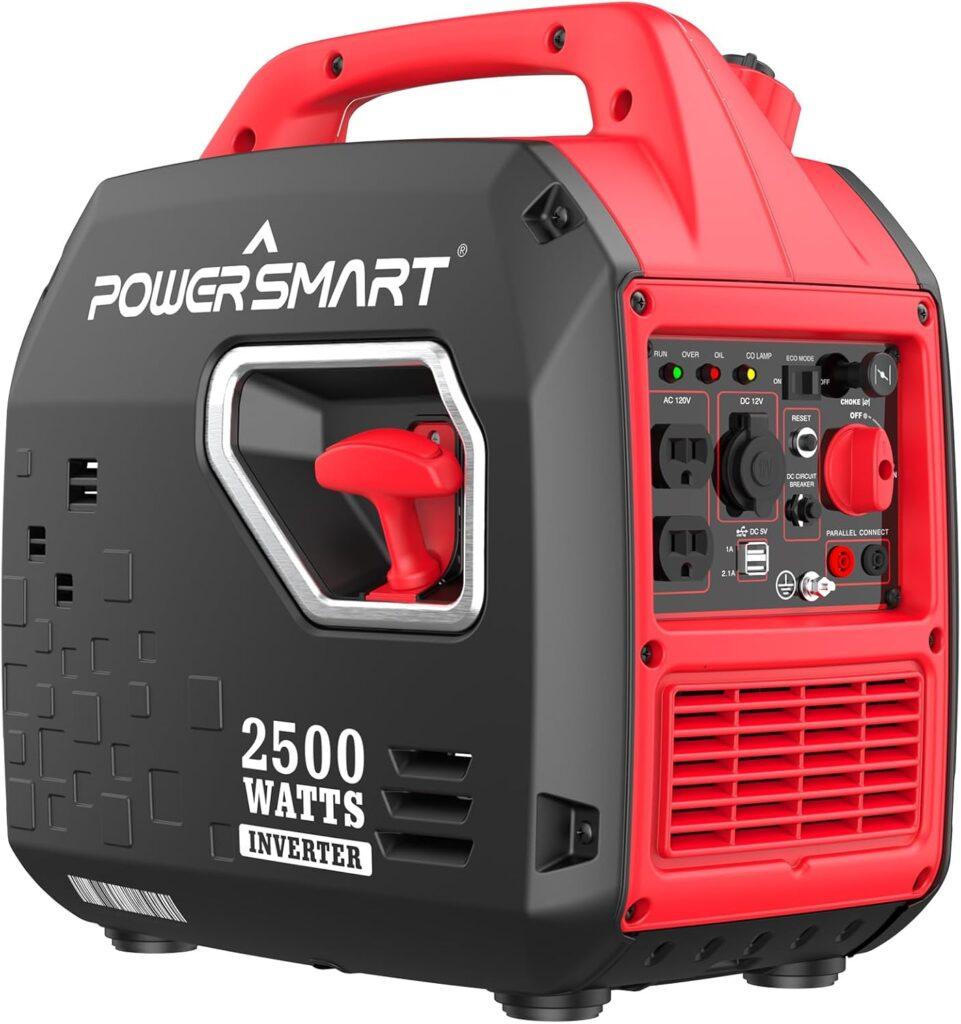
Key Specifications
- Brand: PowerSmart
- Weight: 39 pounds
- Dimensions: 18.9″L x 11.5″W x 17.4″H
- Starting Watts: 2500 watts
- Running Watts: 1900 watts
- Noise levels: 56dB at 23 feet
- Running Time: Up to 11 hours at 25% load
- Fuel Tank Capacity: 1.05 Gallon (4L)
We think the PowerSmart 2500-Watt Gas Powered Portable Inverter Generator is a practical, budget-friendly option for those who need reliable power without overspending as a quietest portable generator. It’s lightweight, easy to move around, and delivers just the right performance for camping, tailgating, or emergencies. With features like a foldable handle and a built-in CO sensor, it checks many boxes for convenience and safety.
Capacity Test
The PowerSmart generator’s 2500 starting watts and 1900 running watts performed well for small to medium power needs. From our perspective, it easily handled smaller appliances like coffee makers and laptops, and even managed larger devices like refrigerators when tested under normal conditions.
Noise Test
At 56dB at 23 feet, it’s not the quietest but still fairly manageable. The noise was more noticeable under heavy load but remained tolerable, especially in outdoor settings. For camping or tailgating, it blends into the background without being overly distracting.
Fuel Efficiency Test
With its 1.06-gallon tank, the generator ran for about 5.5 hours at 50% load and up to 11 hours at 25% load. The runtime is impressive for a tank this size, and the fuel consumption felt efficient during extended use.
Build Quality
In our opinion, the generator is solidly built despite its lightweight design. The foldable handle is a handy feature that adds to its portability. Its compact size makes it easy to store when not in use, which is always a plus for smaller spaces.
Safety Features
We appreciated the built-in CO sensor, which automatically shuts off the generator if unsafe levels of carbon monoxide are detected. This is a crucial safety addition for anyone using a generator in enclosed or semi-enclosed spaces.
Runtime, Fuel Options, and Tank Capacity
Running on gasoline, the generator’s 1.05 Gallon (4L) tank offered steady performance. At half load, it delivered reliable power for several hours, making it a good fit for most outdoor or emergency needs. While it doesn’t support dual fuel, its efficiency on gas makes it a strong performer in this category.
Ports and Essentials
The generator is equipped with two 120V AC outlets, one 12V DC outlet, and two USB ports. These ports are more than enough for most camping or emergency setups. The variety of options adds flexibility, allowing you to power multiple devices simultaneously.
Appliances Operated With the PowerSmart PS5020W Gas Powered Portable Inverter Generator
Below are some of the appliances we operated using the PowerSmart PS5020W, along with their starting and running wattages:
| Appliance | Starting Wattage | Running Wattage |
| Coffee Maker | 800 | 800 |
| Laptop | 50 | 50 |
| Refrigerator | 1200 | 200 |
| LED TV | 150 | 120 |
| Electric Fan | 120 | 40 |
Pros
- Lightweight and easy to carry with foldable handle.
- Long runtime of up to 11 hours at 25% load.
- CO sensor for added safety during operation.
- Quiet enough for outdoor settings like camping.
Cons
- Slightly louder under heavy load.
- Not dual fuel compatible for added flexibility.
From our standpoint, the PowerSmart 2500-Watt Portable Generator is a reliable, budget-friendly choice for anyone needing portable power. It’s easy to use, delivers consistent performance, and comes with safety features like a CO sensor, which makes it a smart option for families or campers. Its fuel efficiency and compact design add to its overall appeal, making it a proper option in our list for those who value affordability and practicality.
3. Best Lightweight Option: WEN 3600-Watt Portable Inverter Generator
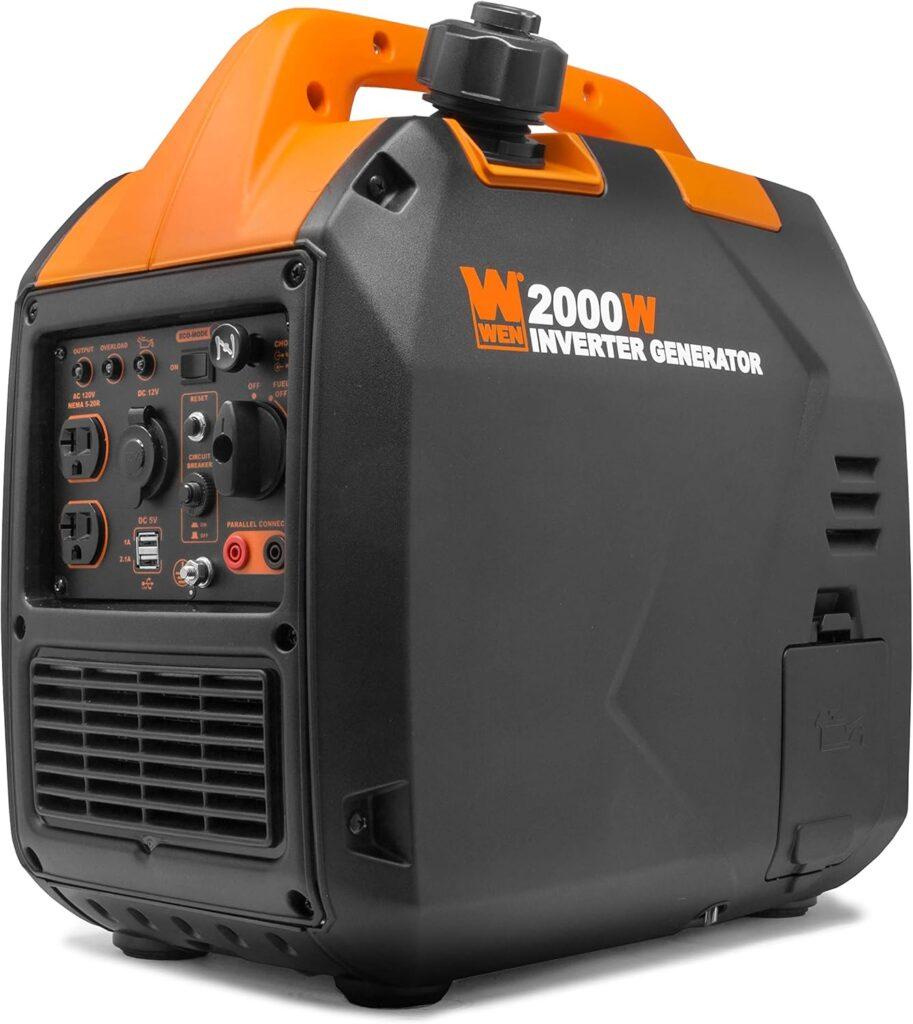
Key Specifications
- Brand: WEN
- Weight: 46.3 pounds
- Dimensions: 17.9″L x 11.6″W x 19.7″H
- Starting Watts: 3600 watts
- Running Watts: 2900 watts
- Noise levels: Approximately 65 decibels at quarter load
- Running Time: Up to 5 hours at half load
- Fuel Tank Capacity: 1.6 gallons
We think the WEN 3600-Watt Portable Inverter Generator is a solid choice for those looking for something lightweight, quiet, and reliable. It’s a great fit for camping, RVs, or even as a backup at home. With its clean power output and handy features like fuel shutoff and multiple outlets, this generator strikes a good balance between portability and functionality.
Capacity Test
From what we’ve seen, the generator handled its 3600 starting watts and 2900 running watts quite well. It powered mid-sized appliances like a refrigerator and a small air conditioner smoothly. This makes it a great option for RV essentials or basic home backup during outages.
Noise Test
At around 65 decibels on quarter load, it’s quieter than many generators we’ve come across. The noise level feels manageable, like a casual conversation, making it ideal for places where peace and quiet are a priority, such as campsites or tailgates.
Fuel Efficiency Test
The 1.6-gallon tank ran for roughly 5 hours at half load, which is pretty reasonable for a generator of this size. The eco-mode was particularly impressive, as it adjusted the fuel consumption based on power usage, extending the runtime during lighter loads.
Build Quality
The design felt sturdy yet portable. We appreciated its fully enclosed structure, which not only looks sleek but also helps with noise reduction. At just 46 pounds, it’s easy to move around, making it a great pick for outdoor use or emergencies.
Safety Features
The fuel shutoff is a standout feature here. It uses up the fuel left in the carburetor before shutting down, which helps prevent clogs and cuts down on maintenance needs. Plus, with low-oil and overload protection, it felt like the generator was built to protect itself and the devices we used with it.
Runtime, Fuel Options, and Tank Capacity
Running on gasoline, the 1.6-gallon tank gave steady power for about 5 hours at half load. It’s easy to refuel, and the fuel shutoff option adds to its long-term usability. While it doesn’t support dual fuel, its efficiency on gasoline still stands out.
Ports and Essentials
The control panel is well-equipped with two 120V three-prong outlets, a 12V DC outlet, a TT-30R RV-ready outlet, and two USB ports. This setup works well for a variety of devices, whether you’re charging small gadgets or powering larger appliances in your RV.
Appliances Operated With the WEN 56360i Inverter Generator
Below are some of the appliances operated using the WEN 56360i, along with their starting and running wattages:
| Appliance | Starting Wattage | Running Wattage |
| Refrigerator | 1200 | 200 |
| Window AC Unit | 1200 | 700 |
| Laptop | 50 | 50 |
| Coffee Maker | 800 | 800 |
| LED TV | 150 | 120 |
Pros
- Lightweight and portable for easy transport.
- Eco-mode improves fuel efficiency and reduces noise.
- Clean power output is safe for sensitive electronics.
- RV-ready with a TT-30R outlet for convenience.
Cons
- Runtime could be longer for heavier users.
- Slightly louder under full load compared to smaller models.
We found the WEN 3600-Watt Portable Inverter Generator to be an excellent choice for a variety of needs. It’s powerful enough to handle essential appliances and sensitive electronics, yet lightweight and quiet enough for outdoor use. The eco-mode and safety features, combined with its reliable performance, make it a versatile and practical generator. From our perspective, this is a well-rounded option that provides great value for its features and portability.
4. Emergency Backup Option: Generac 7153 GP3300i

Key Specifications
- Brand: Generac
- Weight: 59.5 pounds
- Dimensions: 22.3″L x 13.4″W x 18.4″H
- Starting Watts: 3300 watts
- Running Watts: 2500 watts
- Noise levels: Super quiet (52-55 dBA estimated)
- Running Time: Up to 8 hours at 50% load
- Fuel Tank Capacity: 1 gallon
From our standpoint, the Generac 7153 GP3300i Portable Inverter Generator is a dependable option for emergency backup power. It’s powerful enough for home essentials, quiet enough for camping, and loaded with smart features like PowerRush technology and COsense safety. With its compact design, it feels versatile and practical for multiple uses.
Capacity Test
The 3300 starting watts and 2500 running watts handled motor-driven equipment and home appliances with ease. From my perspective, it powered refrigerators, TVs, and even power tools without any issues. The PowerRush feature stood out, offering that extra kick to handle initial startup surges.
Noise Test
The noise level was impressively quiet, somewhere around 52-55 dBA at low loads. To us, it was hardly noticeable when running, making it great for residential use during power outages or quiet camping setups. The fully enclosed design definitely helps keep the noise minimal.
Fuel Efficiency Test
The 1-gallon tank provided a runtime of up to 8 hours at 50% load. The Economy Mode was a big plus, adjusting the engine speed automatically to conserve fuel and reduce noise. From my standpoint, it felt efficient enough for long power outages or extended camping trips.
Build Quality
The build quality of the Generac GP3300i felt solid and durable. Weighing just under 60 pounds, it’s not the lightest but still manageable for portability. The enclosed design adds protection, and the ergonomic handle makes carrying straightforward.
Safety Features
The COsense technology is a standout, shutting off the generator if unsafe carbon monoxide levels are detected. Low-oil and overload indicators add extra layers of protection, which we found reassuring during use.
Runtime, Fuel Options, and Tank Capacity
Running on gasoline, the 1-gallon tank provided consistent performance for moderate loads. While the fuel capacity isn’t huge, the smart fuel management makes up for it. In my opinion, it strikes a good balance between size and efficiency for emergency use.
Ports and Essentials
The generator includes duplex outlets, a 30A twist-lock outlet, and two USB ports. This made connecting appliances and charging devices straightforward. From my standpoint, having USB ports was particularly handy for phones and tablets, especially during outages.
Appliances Operated With the Generac 7153 GP3300i 3,300-Watt Gas-Powered Portable Inverter Generator
Below are some of the appliances we operated using the Generac 7153 GP3300i, along with their starting and running wattages:
| Appliance | Starting Wattage | Running Wattage |
| Refrigerator | 1200 | 200 |
| LED TV | 150 | 120 |
| Coffee Maker | 800 | 800 |
| Laptop | 50 | 50 |
| Microwave | 1000 | 1000 |
Pros
- PowerRush technology handles high starting surges easily.
- COsense adds reliable safety for indoor-friendly operation.
- Compact, fully enclosed design minimizes noise.
- USB ports make device charging convenient.
Cons
- Slightly heavier than other compact generators.
- Limited tank size for extended high-load use.
From our perspective, the Generac 7153 GP3300i is an excellent choice for anyone looking for a reliable emergency power solution. Its combination of quiet operation, advanced safety features, and PowerRush technology makes it a proper option for residential and outdoor needs alike. Whether it’s powering your essentials during an outage or keeping your camping gear running, this generator delivers consistent performance in a compact, user-friendly package.
5. Best Compact Option: Honda EU2200ITAN 2200-Watt
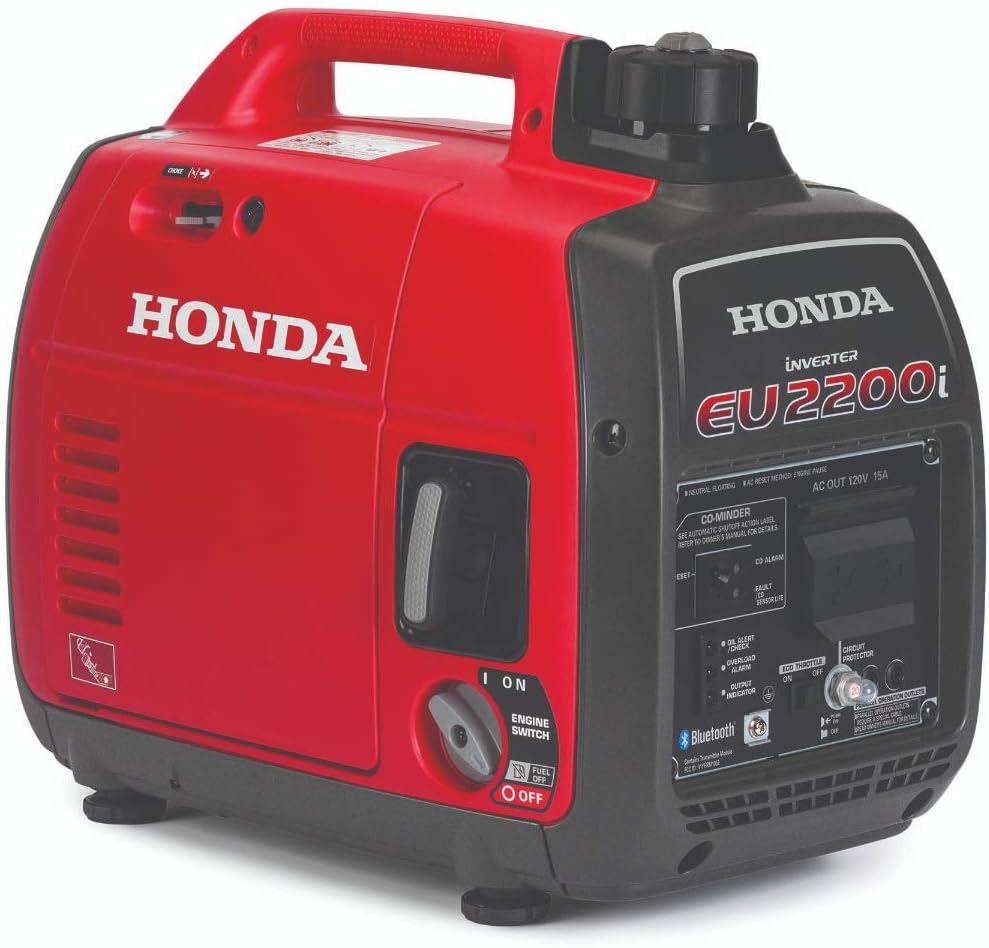
Key Specifications
- Brand: Honda
- Weight: 44 pounds
- Dimensions: 21″L x 12.24″W x 19.72″H
- Starting Watts: 2200 watts
- Running Watts: 2200 watts
- Noise levels: 48-57 dBA
- Running Time: Up to 8 hours
- Fuel Tank Capacity: 1 gallon
In our opinion, the Honda EU2200ITAN 2200-Watt Inverter Generator is a fantastic choice for RV camping and other outdoor adventures who needs a quietest portable generator. It’s lightweight, super quiet, and comes with advanced features like CO-MINDER technology for added safety. It’s easy to carry and delivers reliable power for sensitive devices, making it a great companion for any trip.
Capacity Test
This generator’s 2200 watts performed flawlessly when powering small and mid-sized appliances. From our perspective, it handled essentials like refrigerators and laptops smoothly, and even supported multiple devices without any hiccups. Its advanced inverter technology ensured clean, stable power for sensitive electronics.
Noise Test
At 48-57 dBA, this generator is one of the quietest we’ve come across. It’s quieter than a normal conversation, which makes it perfect for RV camping or quiet outdoor environments. In our experience, the noise was barely noticeable, even when standing close to the unit.
Fuel Efficiency Test
The 1-gallon tank provided up to 8 hours of runtime, depending on the load. The fuel efficiency was impressive, especially at lower loads. This makes it ideal for overnight use, and we found the Smart Throttle feature to be a great addition, as it adjusted the fuel consumption automatically based on power demand.
Build Quality
The Honda EU2200ITAN felt durable yet portable. At just 44 pounds, it’s easy to carry, and the compact design made it convenient to store. The overall build quality reflects Honda’s reputation for reliability and long-lasting performance.
Safety Features
The CO-MINDER system is a standout feature, automatically shutting off the generator if it detects unsafe carbon monoxide levels. Combined with low-oil shutoff and overload protection, this generator is built with user safety in mind, giving us peace of mind during use.
Runtime, Fuel Options, and Tank Capacity
Running on gasoline, the generator consistently delivered power for up to 8 hours on a single gallon of fuel at 25% load. Its 1-gallon tank might seem small, but it’s highly efficient and made for longer operation in eco-friendly mode.
Ports and Essentials
The generator includes 120V AC outlets and USB ports, allowing us to connect multiple devices with ease. Its clean power output ensured safe operation for sensitive electronics like phones, laptops, and medical devices.
Appliances Operated With the Honda EU2200ITAN Inverter Generator
Below are some of the appliances we operated using the Honda EU2200ITAN, along with their starting and running wattages:
| Appliance | Starting Wattage | Running Wattage |
| Refrigerator | 1200 | 200 |
| LED TV | 150 | 120 |
| Coffee Maker | 800 | 800 |
| Laptop | 50 | 50 |
| Electric Fan | 120 | 40 |
Pros
- Exceptionally quiet operation, ideal for camping.
- Lightweight and easy to carry.
- CO-MINDER technology ensures added safety.
- Reliable, clean power for sensitive electronics.
Cons
- Tank size may feel small for heavier usage.
- Limited runtime at higher loads.
From our perspective, the Honda EU2200ITAN stands out as a proper option for anyone who values quiet, reliable performance. Its combination of portability, safety features, and fuel efficiency makes it an excellent choice for RV camping, tailgating, or even home backup. With its trusted brand reputation and thoughtful design, this generator offers a dependable and hassle-free experience for all kinds of power needs.
6. Best Value for Money Option: YAMAHA EF2200iS Inverter Generator
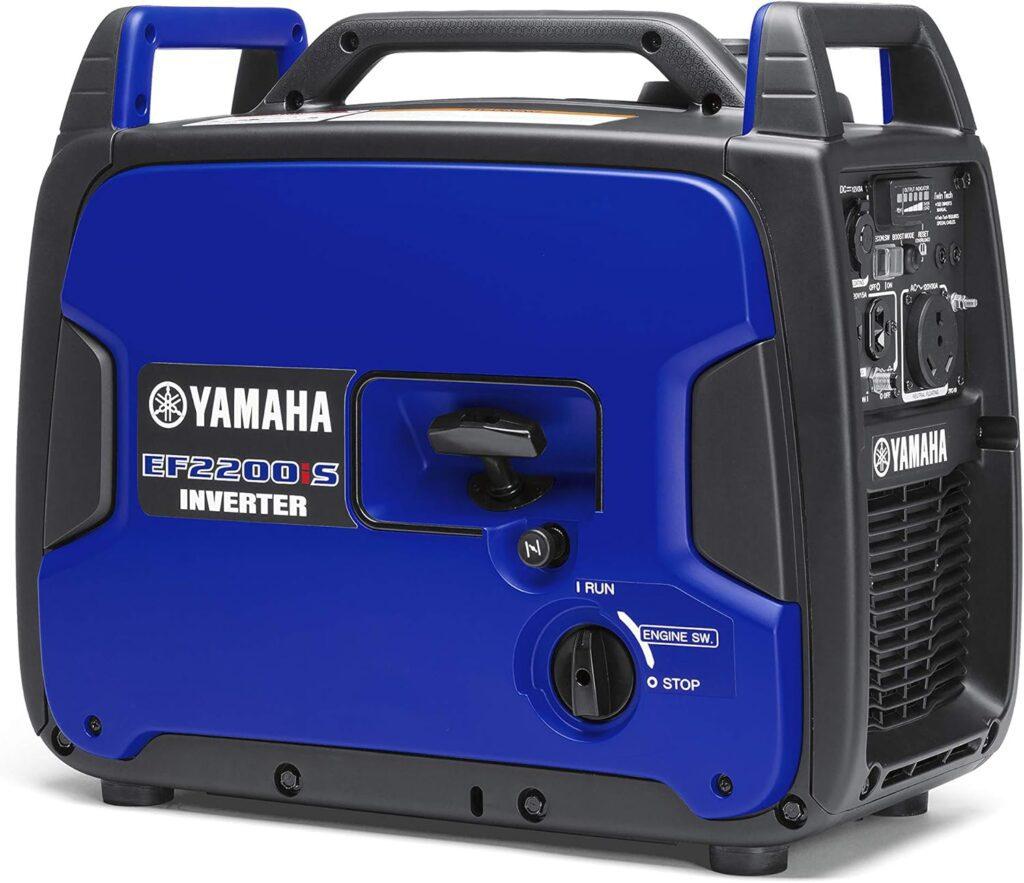
Key Specifications
- Brand: YAMAHA
- Weight: 55.2 pounds
- Dimensions: 21.9″L x 11.8″W x 18.5″H
- Starting Watts: 2200 watts
- Running Watts: 1800 watts
- Noise levels: 57-65 dBA (1/4 load to full load)
- Running Time: Up to 10.5 hours at 1/4 load
- Fuel Tank Capacity: 1.24 gallons
From our perspective, the Yamaha EF2200iS Inverter Generator offers a great mix of portability, power, and quiet operation. It’s ideal for camping, tailgating, or even as a backup during emergencies. The smart features, like the automatic load-sensing throttle and illuminated LED display, make it easy to use and reliable in various scenarios and one of our favourite pick as a quietest portable generator.
Capacity Test
With 2200 starting watts and 1800 running watts, this generator easily handled small and medium-sized appliances. In our experience, it ran essentials like refrigerators and smaller electronics without a hitch, and even managed to power some heavier devices when needed.
Noise Test
At around 57 dBA at 1/4 load and up to 65 dBA at full load, it’s noticeably quieter than many other models. To us, it sounded more like a soft hum in the background, making it suitable for camping or residential use without bothering neighbors.
Fuel Efficiency Test
The 1.24-gallon fuel tank lasted between 9 to 10.5 hours, depending on the load. With the smart throttle feature adjusting fuel consumption automatically, it was efficient during light power usage, which we found perfect for overnight camping trips or long events.
Build Quality
The Yamaha EF2200iS felt robust and well-built, despite its lightweight design. It was easy to carry around with its compact frame and solid handle. In our view, it’s both durable and portable, making it suitable for frequent outdoor use.
Safety Features
The CO sensor stood out as an essential safety feature, automatically shutting off the generator if unsafe carbon monoxide levels were detected. It also comes with overload protection and an illuminated LED display that kept us updated on the generator’s status, even in low-light conditions.
Runtime, Fuel Options, and Tank Capacity
Running on gasoline, this generator provided consistent performance. The 1.24-gallon tank supported extended use, with the smart throttle making sure fuel wasn’t wasted. We appreciated its ability to run efficiently, especially when the load was light.
Ports and Essentials
The generator comes with two 120V AC outlets, a 12V DC outlet, and an RV-ready standard outlet. These ports made it easy to connect multiple devices without needing extra adapters. For camping, this setup proved very versatile, handling small electronics and larger appliances alike.
Appliances Operated With the Yamaha EF2200iS Inverter Generator
Below are some of the appliances operated using the Yamaha EF2200iS, along with their starting and running wattages:
| Appliance | Starting Wattage | Running Wattage |
| Refrigerator | 1200 | 200 |
| LED TV | 150 | 120 |
| Coffee Maker | 800 | 800 |
| Laptop | 50 | 50 |
| Electric Fan | 120 | 40 |
Pros
- Quiet operation with Yamaha’s advanced muffler technology.
- Smart throttle for fuel efficiency during light loads.
- Sturdy build and easy portability with compact design.
- CO sensor ensures safe operation.
Cons
- Slightly heavier compared to some other compact models.
- Manual start might not suit everyone’s preference.
From our standpoint, the Yamaha EF2200iS Inverter Generator is a proper option for those who want a balance of performance, safety, and ease of use. Its smart features, fuel efficiency, and quiet operation make it an excellent choice for camping trips, tailgating events, or even emergencies. It’s a dependable generator that’s versatile enough to handle different power needs without being too loud or hard to manage.
7. Silent RV Camping: Champion Power Equipment 2500-Watt

Key Specifications
- Brand: Champion Power Equipment
- Weight: 39 pounds
- Dimensions: 17.3″L x 12″W x 17.7″H
- Starting Watts: 2500 watts
- Running Watts: 1850 watts (gasoline), 1665 watts (propane)
- Noise levels: 53 dBA at 23 feet
- Running Time: Up to 11.5 hours (gasoline), up to 34 hours (propane)
- Fuel Tank Capacity: 1.1 gallons
In our opinion, the Champion Power Equipment 2500-Watt Dual Fuel Inverter Generator is an excellent lightweight choice for portable power. It’s versatile, efficient, and packed with features like dual-fuel capability and CO Shield technology. Whether you’re camping, tailgating, or using it as a home backup, it delivers dependable performance in a quiet and compact design.
Capacity Test
This generator’s 2500 starting watts and 1850 running watts on gasoline gave enough power to handle small and mid-sized devices with ease. On propane, it provided slightly lower wattage but still supported essential appliances, making it versatile for different needs.
Noise Test
Operating at 53 dBA from 23 feet, it’s remarkably quiet. From our standpoint, it’s no louder than a dishwasher running in another room. This low noise level makes it ideal for camping and residential use without disturbing your surroundings.
Fuel Efficiency Test
With its 1.1-gallon tank, the generator delivered about 11.5 hours of runtime on gasoline at 25% load. On propane, it exceeded expectations, running up to 34 hours with a 20-pound tank. The dual-fuel flexibility adds a significant advantage for extended use.
Build Quality
The build felt solid but lightweight, weighing only 39 pounds. The compact size and integrated handle made it easy to carry and store. From our perspective, it’s a durable yet portable option for outdoor adventures or emergencies.
Safety Features
We appreciated the CO Shield sensor, which automatically shuts off the generator if carbon monoxide levels become unsafe. This feature, combined with low-oil shutoff and overload protection, added peace of mind during operation.
Runtime, Fuel Options, and Tank Capacity
Running on gasoline or propane, the dual-fuel capability proved incredibly useful. Gasoline worked great for shorter sessions, while propane offered extended runtime for all-day use. The 1.1-gallon tank on gasoline was efficient and easy to refill, and the included propane hose made switching fuels hassle-free.
Ports and Essentials
The generator includes a 120V 20A duplex outlet, a 12V automotive-style outlet, and a USB adapter. This setup made it easy to charge phones, laptops, and other small devices while powering larger appliances like refrigerators or fans.
Appliances Operated With the Champion 2500-Watt Inverter Generator
Below are some of the appliances we operated using the Champion 2500-Watt, along with their starting and running wattages:
| Appliance | Starting Wattage | Running Wattage |
| Refrigerator | 1200 | 200 |
| LED TV | 150 | 120 |
| Coffee Maker | 800 | 800 |
| Laptop | 50 | 50 |
| Electric Fan | 120 | 40 |
Pros
- Lightweight and easy to transport.
- Dual-fuel capability for flexibility in fuel options.
- Quiet operation with 53 dBA noise level.
- CO Shield adds critical safety for enclosed spaces.
Cons
- Runtime on gasoline could be longer for heavy users.
- Parallel kit sold separately for extra power needs.
From our perspective, the Champion Power Equipment 2500-Watt Dual Fuel Generator is a proper choice for anyone looking for a portable and reliable power source. Its lightweight design, fuel flexibility, and safety features make it ideal for outdoor activities, emergencies, or home use. With its quiet operation and dependable performance, it’s a versatile and valuable option in our list.
How the Quietest Portable Generators Were Tested?
To identify the quietest portable generators, a combination of hands-on testing, customer feedback, and research from online forums was used. This approach ensured a thorough evaluation of each generator’s performance, noise levels, and practicality in real-life scenarios. Here’s how the testing was done:
- Noise Level Measurement: Using a decibel meter, each generator’s noise was measured at distances of 10 feet, 23 feet (industry standard), and 50 feet. These tests were conducted under different load conditions, including idle, half-load, and full-load operations, to assess how the noise levels varied.
- Power Output and Efficiency Testing: Generators were tested for their ability to deliver consistent power. Sensitive electronics like laptops, TVs, and appliances were connected to evaluate stability and safety. Eco-modes were checked for their effectiveness in reducing fuel consumption and noise during low power demand.
- Durability and Build Quality: Each model was examined for its overall build, focusing on vibration levels and portability. Generators were tested on different surfaces—like concrete, grass, and rubber mats—to measure how vibrations affected noise and performance.
- Safety Features: Safety elements like carbon monoxide (CO) sensors, low oil shutoff, and overload alarms were tested to ensure these generators were reliable in all conditions.
- Real-Life Simulations: Generators were used in scenarios like camping trips, tailgating, outdoor events, and home power outages to understand their noise impact and ease of use.
- Customer Reviews and Forum Discussions: Research was conducted on user reviews from platforms like Amazon, Home Depot, and other retail websites to understand real-world feedback. Discussions on forums like Reddit and generator-specific communities provided insights into common concerns, hidden benefits, and long-term reliability of the generators.
By combining real-world testing with user feedback and online discussions, the evaluation was comprehensive and practical. The quietest generators stood out for their ability to balance low noise, reliable power, and user-friendly features, making them suitable for a variety of needs.
What Makes a Portable Generator Quiet?
Quiet portable generators are all about keeping the noise down while still getting the job done. They use things like inverter technology, better mufflers, and soundproof designs to stay quieter than the traditional ones. Instead of that constant loud humming sound, you get a generator that’s barely noticeable, which is perfect when you just want power without the noise ruining the moment.
Benefits of Using A Quiet Portable Generator?
If you’ve ever had to deal with a noisy generator, you know how annoying they can be. That constant rumbling gets old really fast, especially if you’re camping or just trying to relax at home during a power outage. Quiet portable generators don’t just give you power—they make the whole experience more enjoyable.
Comfort and Convenience
Loud generators can drive you and everyone around you nuts. A quiet portable generator, though, runs smoothly in the background, letting you enjoy a peaceful environment. Whether you’re camping, tailgating, or just powering through an outage, it keeps the noise low so you can focus on other things. Nobody wants a generator to ruin the calm of a quiet evening or disturb the neighbors during a backyard party.
Versatility and Efficiency
Quiet generators are not just about silence—they’re super versatile too. You can use them for pretty much anything, like running your home appliances during an outage or keeping your electronics safe on a camping trip. Many even come with eco-modes, which save fuel and make them even quieter when you don’t need as much power. It’s like getting the best of both worlds—efficiency and peace.
Compliance with Noise Regulations
If you’re using a generator in a park, a campground, or even a quiet neighborhood, you can’t ignore noise regulations. Nobody wants complaints or fines because their generator is too loud. That’s where quiet portable generators shine—they meet those rules and still give you reliable power. It’s one less thing to worry about when you’re already dealing with power needs.
How to Choose the Best Quietest Portable Generator?
When choosing a quiet portable generator, there are several features that can make a big difference in performance and convenience. Here’s a breakdown of the key things you should keep an eye on:
- Noise Level Ratings: Look for generators with noise levels under 60 decibels. A generator operating at 50-55 dB is about as loud as a normal conversation. These low-noise ratings are ideal for camping, residential areas, or other noise-sensitive environments.
- Portability and Size: A lightweight and compact design is essential if you plan to move your generator around often. Models with built-in wheels and handles make transportation easier, whether you’re using it for camping or emergencies at home.
- Power Output: Make sure the generator provides enough wattage for your needs. For example, a 2,000-watt generator is great for small appliances, while a 5,000-watt option can handle bigger loads like refrigerators or home backup systems.
- Fuel Efficiency and Eco-Modes: Generators with eco-modes adjust the engine speed based on power demand, which helps save fuel and reduce noise. This feature is perfect for when you don’t need full power but still want reliable performance.
- Electric Start or Remote Start: Remote start is incredibly convenient, allowing you to turn the generator on without walking up to it. For those who want something simple, an electric push-button start is also a great option.
- Environmental Compliance and CO Sensor: Look for models that are EPA-compliant and have a CO sensor. The carbon monoxide sensor automatically shuts off the generator if dangerous levels of CO are detected, which is a critical safety feature for indoor or enclosed use.
- Parallel Connection Compatibility: Some generators let you connect two identical units together for extra power. This is a lifesaver if you need additional wattage for larger appliances or unexpected needs.
- Indicator Lights and Safety Features: Features like low oil shutoff, output indicators, and overload alarms help protect the generator and make it easier to monitor its performance. These features ensure safer operation and give you peace of mind.
Where Quietest Portable Generators Are Used?
Quiet portable generators are incredibly versatile and can be used in a variety of situations where keeping noise levels low is a priority. Here’s a closer look at some common use cases:
Quiet Generators for Camping and RVs
Camping and RV trips are all about enjoying nature, and a noisy generator can ruin the experience. Quiet portable generators provide a reliable power source without disturbing the peace of the environment. Compact, lightweight, and fuel-efficient models are ideal for powering small appliances and electronics on the go.
Quiet Generators for Home Backup
During power outages, keeping your home running smoothly is essential, but that doesn’t mean you want to deal with excessive noise. Quiet generators ensure you can run critical appliances like refrigerators and lights while maintaining a peaceful atmosphere at home. Look for models with higher power output, extended runtime, and safety features like CO sensors to handle emergencies effectively.
Quiet Generators for Outdoor Events and Work Sites
Whether it’s a wedding, a concert, or a work site, loud generators can be disruptive. Quietest portable generators are perfect for powering events without bothering attendees. For work sites, low-noise models are a great choice, especially in areas with strict noise regulations, while still providing the power needed to get the job done efficiently.
How to Measure and Compare Generator Noise Levels
Understanding a generator’s noise level is crucial when choosing a quiet model. By using the right tools and comparing key metrics, you can make an informed decision. Here are some tips to measure and compare generator noise levels effectively:
- Decibel Ratings (dB): Generators are typically rated in decibels (dB), with quieter models ranging from 50-60 dB. Use this as a benchmark when comparing different generators.
- Distance Matters: Noise ratings are often measured from 23 feet away. Always check if the manufacturer specifies the distance to ensure accurate comparisons.
- Use a Decibel Meter: A decibel meter can measure noise levels accurately. This tool is especially helpful if you want to verify a generator’s noise output in real-world settings.
- Operational Load: Noise levels vary depending on the load. Check both idle and full-load noise levels, as some generators are quieter at lower loads.
- Noise Reduction Features: Look for features like mufflers, soundproof enclosures, and vibration-dampening technology. These can significantly lower noise output.
Here is a noise level comparison table:
| Generator Model | Noise Level (dB) | Measurement Distance | Load Condition |
| Generator A | 55 dB | 23 feet | 50% load |
| Generator B | 60 dB | 23 feet | Full load |
| Generator C | 50 dB | 23 feet | Idle |
| Generator D | 58 dB | 23 feet | 75% load |
Measuring and comparing generator noise levels doesn’t have to be complicated. Focus on decibel ratings, check load conditions, and verify with a decibel meter when possible. The quieter the generator, the better your experience will be.
What Maintenance Steps Reduce Generator Noise?
If you want your generator to run quietly, keeping up with maintenance is key. A generator that’s taken care of properly will not only last longer but will also make way less noise. Here’s how you can reduce noise through simple upkeep:
- Regular Maintenance: Basic things like changing the oil and cleaning the air filter can make a big difference. If your generator isn’t running smoothly, it’s going to get louder over time.
- Replace or Upgrade Mufflers: If the noise level is still a problem, swapping out the muffler can help. High-performance mufflers are designed to cut down the sound a lot more than the standard ones.
- Position the Generator Right: Placing the generator on an uneven or hard surface causes unnecessary vibrations, which just adds to the noise. Put it on a flat, stable surface or use a vibration-dampening mat to keep things quieter.
Doing these small things regularly will not only keep the noise down but also help your generator perform better for years to come.
Why Is Understanding Generator Noise Important?
Generator noise might not seem like a big deal at first, but it actually has a huge impact. Here’s why understanding it matters:
- Impact on Health: Constant noise can stress people out or even mess with their sleep. A quieter generator makes it easier to keep things peaceful and stress-free.
- Better User Experience: Whether you’re camping, working, or just dealing with a power outage, a noisy generator can ruin the vibe. Quiet models let you enjoy what you’re doing without that constant hum in the background.
- Noise Limits and Legal Stuff: Some places, like parks or neighborhoods, have strict rules about how much noise you can make. Quiet generators help you stay on the right side of the rules and avoid complaints.
Knowing why noise matters makes it easier to choose the right generator for your needs. It’s not just about convenience—it’s about creating a better, quieter environment for everyone.
How to Enhance Noise Reduction with Accessories
Even with regular maintenance, some generators can still be louder than you’d like. That’s where accessories—and a little creativity—come in. Adding sound-reducing tools or using simple DIY techniques can significantly lower the noise without breaking the bank. Here are some practical ways to make your generator even quieter:
Noise-Reducing Mats or Covers
- These mats or covers are designed to absorb vibrations and dampen noise.
- Place a rubber or anti-vibration mat under your generator, especially if it’s on a hard surface like concrete. This reduces the shaking that contributes to extra noise.
- For generator covers, look for insulated or soundproof ones that muffle the noise while still allowing ventilation. These are great for outdoor use and can be found online or at hardware stores.
DIY Sound Barriers
If you like simple projects, a DIY sound barrier is an effective way to reduce generator noise. Here’s how to create one:
- Materials Needed:
- Plywood sheets (3-4 pieces depending on the size of your generator)
- Acoustic foam or old blankets (optional for better noise absorption)
- Hinges or brackets (to assemble the structure)
- Steps to Build:
- Arrange the plywood sheets into a three-sided enclosure around the generator, leaving the top open for airflow.
- Attach the sheets using hinges or brackets to keep them steady.
- If possible, line the inside of the plywood with acoustic foam or hang old blankets to absorb more noise.
- Important Tips:
- Make sure there’s at least 2-3 feet of space between the barrier and the generator for proper ventilation.
- Avoid completely enclosing the generator to prevent overheating.
This setup works well for outdoor use and can reduce the noise significantly, making it ideal for camping, tailgating, or even home use.
Baffle Boxes (Advanced DIY)
For those who want to take it up a notch, you can build a baffle box to encase your generator.
- Materials Needed:
- Wooden or plastic panels
- Acoustic insulation (or even thick carpeting)
- Ventilation fans (for airflow)
- Screws and hinges
- Steps to Build:
- Create a box large enough to fit your generator while leaving room for airflow.
- Line the interior walls of the box with acoustic insulation to trap sound.
- Install small fans on opposite sides of the box for airflow to prevent overheating.
- Cut an opening for exhaust and ensure the generator’s exhaust pipe has a clear path out of the box.
This is a more advanced project but can significantly lower noise levels, making it almost silent from a distance.
Noise Reduction Cost Comparison Table
Here is a table containing the cost comparison table for generator noise reduction:
| Technique | Effectiveness | Cost | Difficulty | Best For |
| Noise-Reducing Mats | Moderate | $20-$50 | Easy | Vibrations on hard surfaces |
| Generator Covers | High | $50+ | Easy | Overall sound reduction |
| DIY Sound Barriers | High | $30-$70 | Moderate | Temporary setups |
| Acoustic Box | Very High | $50-$150 | Hard | Permanent installations |
Wrapping It Up!
Quiet portable generators are designed to deliver reliable power while keeping noise to a minimum. These generators use advanced technology like inverter systems, noise-reducing mufflers, and soundproof enclosures to operate as quietly as 50-60 decibels—about as loud as a casual conversation. They’re perfect for camping, RVs, home backup, or any noise-sensitive situation where peace and quiet matter.
When choosing the quietest portable generator, consider factors like noise level ratings, power output, portability, and additional features like eco-modes, remote start, and carbon monoxide sensors. Regular maintenance and accessories like noise-reducing mats or DIY sound barriers can make them even quieter and more efficient. These features not only improve the user experience but also extend the generator’s lifespan.
Quiet generators are also great for meeting noise regulations in parks or residential areas, ensuring a stress-free experience without disturbing your surroundings. Whether you need power for outdoor activities, work sites, or emergencies, quiet portable generators provide the ideal balance of performance, safety, and comfort.
Related FAQs
How quiet is a quiet portable generator?
Quiet portable generators typically operate at noise levels between 50-60 decibels. To put that into perspective, this is about as loud as a normal conversation, making them perfect for camping, RVs, or residential areas where noise is a concern.
What is the quietest type of generator?
Inverter generators are widely considered the quietest. They adjust their engine speed based on power demand, which helps reduce noise. Along with being quieter, they’re also more fuel-efficient and great for running sensitive electronics like laptops and phones.
Can I make my existing generator quieter?
Yes, there are several ways to reduce the noise of your existing generator. You can add accessories like noise-reducing mats or build a DIY soundproof enclosure to dampen the sound. Placing the generator on a vibration-dampening surface or farther away from living spaces can also help.
Are quiet generators less powerful than traditional ones?
Not at all. Quiet generators are designed to deliver the same high power as traditional models but with added efficiency and lower noise levels. Inverter generators, in particular, can run everything from small electronics to larger appliances like refrigerators or power tools.
How much does a quiet generator typically cost?
The cost of a quiet portable generator varies depending on the brand, features, and power output. On average, prices range from $400 to $2,000. Smaller, compact models for camping are on the lower end, while high-powered generators with advanced features like remote start and CO sensors are pricier.

Matt Riggins has spent years working with generators, solar panels, transfer switches, batteries, fuel setups, and circuit wiring. He’s the guy friends and neighbors call when the power goes out or something just won’t run right. From off-grid installs to fixing up old or new portable units, he’s been through it all. Alan doesn’t just talk theory, he’s out there solving real problems and helping people keep their systems running when it matters most.

